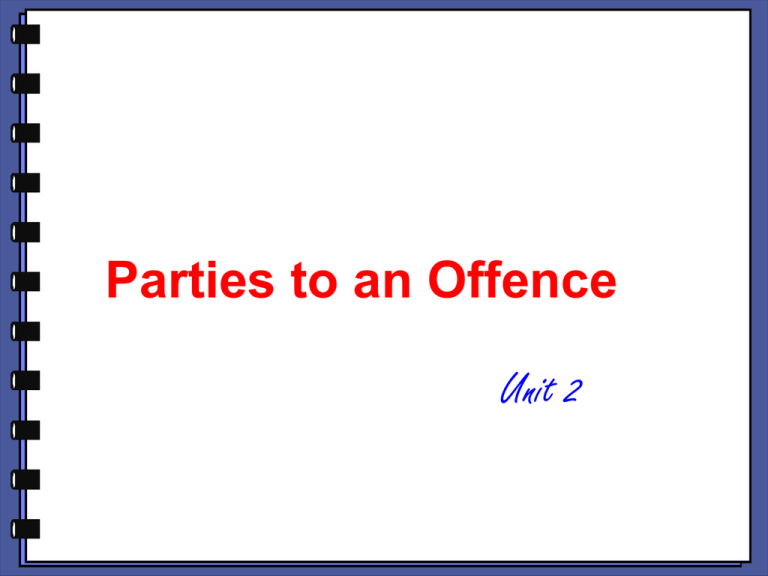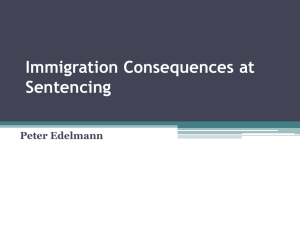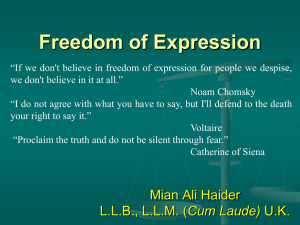Parties to an Offence
advertisement

Parties to an Offence Unit 2 Parties to an Offence • • • • • • Perpetrator Aiding Abetting Counseling Procuring Accessory after the Fact Perpetrator • the person who actually commits the offence or performs the act described in the offence. • Can be more than one perpetrator. • For example, the person who points the gun at a bank teller or grocery clerk and demands money is the perpetrator. • In all cases, the perpetrator must be present at the scene of the offence. Criminal Code of Canada • 21. (1) Every one is a party to an offence who – (a) actually commits it; (Perpetrator) – (b) does or omits to do anything for the purpose of aiding any person to commit it (Aider); or – (c) abets any person in committing it. (Abettor) (2) Where two or more persons form an intention in common to carry out an unlawful purpose and to assist each other therein and any one of them, in carrying out the common purpose, commits an offence, each of them who knew or ought to have known that the commission of the offence would be a probable consequence of carrying out the common purpose is a party to that offence. Aiding / Aider •This person does something or omits to do something which aids the commission of the offence. •Person knows a crime is being committed and still helps in some way. •To aid in the commission of an offence, one does not have to be present when the offence is committed. Aiding / Aider Example #1: • Person A supplies a key to Person B for the purpose of entering and robbing a store. Person A is an aider even though he does not attend the robbery. Example #2: • Person A leaves a safe unlocked (omits to do something) or fails to lock a back window or door so that his friend can enter to commit theft. Person A is an aider. Criminal Code of Canada • 21. (1) Every one is a party to an offence who – (a) actually commits it; (Perpetrator) – (b) does or omits to do anything for the purpose of aiding any person to commit it (Aider); or – (c) abets any person in committing it. (Abettor) (2) Where two or more persons form an intention in common to carry out an unlawful purpose and to assist each other therein and any one of them, in carrying out the common purpose, commits an offence, each of them who knew or ought to have known that the commission of the offence would be a probable consequence of carrying out the common purpose is a party to that offence. Abetting •is a person who encourages, either orally or passively the commission of the offence. (Abet means to encourage.) •An abettor must be present at the scene of the offence. •A bystander who watches an offence and does not intervene, is not abetting that offence. Abetting • Note the significant difference between an aider and an abettor: The aider does not necessarily have to attend the scene of the offence while an abettor must be present. • For example, Person A assaults Person C. Person A does the actual physical assault, while Person B encourages him on. Person B is an abettor. Criminal Code of Canada • 21. (1) Every one is a party to an offence who – (a) actually commits it; (Perpetrator) – (b) does or omits to do anything for the purpose of aiding any person to commit it (Aider); or – (c) abets any person in committing it. (Abettor) (2) Where two or more persons form an intention in common to carry out an unlawful purpose and to assist each other therein and any one of them, in carrying out the common purpose, commits an offence, each of them who knew or ought to have known that the commission of the offence would be a probable consequence of carrying out the common purpose is a party to that offence. What roles did each person play in this assault? •A, B and C decide to beat up a policeman who is on foot patrol. A punches the policeman while B acts as a lookout. C stands back and shouts encouragement to A such as: "Hit him, kick him, etc." Person counselling offence • 22. (1) Where a person counsels another person to be a party to an offence and that other person is afterwards a party to that offence, the person who counselled is a party to that offence, notwithstanding that the offence was committed in a way different from that which was counselled. • (2) Every one who counsels another person to be a party to an offence is a party to every offence that the other commits in consequence of the counselling that the person who counselled knew or ought to have known was likely to be committed in consequence of the counselling. • (3) For the purposes of this Act, “counsel” includes procure, solicit or incite. Counseling • a person who – organizes the commission of a crime, – advises others on how to carry it out, – supplies equipment with which to commit the crime • a person who counsels does not have to be at the scene of the crime to be guilty • It is often difficult to prove that a person counseled someone to commit a crime, so this needs to be considered carefully before charges are laid. Procuring •a person who: – recruits other people to carry out the crime. (Procuring) •It is often difficult to prove. •Hiring a hitman •Parent getting someone to beat another person up for them. •Gang initiation etc.. NOTE!!!!! • Not only are parties to an offence guilty of the offence originally intended, • BUT they are also guilty of any other offence that occurs as a probable consequence of their original intention. • For example, A and B plan to push Person C around just for fun. A holds C while B hits C in the face, breaking C's jaw. They did not plan to break C's jaw but this was a consequence of the original intention of common assault. Both could now be charged with assault causing bodily harm because of the injury sustained by C. Accessory after the Fact • Parties to the offence after the offence has taken place. • Knowing that an offence has occurred that someone is a party to an offence • but only knowing about the offence afterwards. • receives, comforts or assists that person for the purpose of escape. • Only exception…. A spouse!! Accessory after the Fact •For example, Person A commits a theft, during which he injures himself. He reports to a doctor to have the injury treated. Following treatment he goes to the house of a friend, who, after learning of the offence, offers his home as a hide-out. Case…check!? • Person A owes Person B $5,000.00, but is unable to pay. They meet and agree to rob a grocery store, part of the proceeds to be used to repay the loan. Person B provides the layout of the store, the hours of operation and how to get to the payroll. He also volunteers to recruit two other people to help with the job. • Person A, C and D enter the grocery store to commit the robbery. C forces all the patrons to the back of the store to keep them out of the way. Person A encourages person D to open the strong box and take all the money, which he does. • All three leave the store and make their get away on foot. They meet at the home of Person B where they divide up the money. The wife of Person B agrees to house the participants for several days until things cool off. What role did each play? • • • • • • • • • • • A is the abettor; B is an aider to the offence; C is an aider to the offence; D is the perpetrator; B's wife is an accessory after the fact to A, C and D, but not an accessory after the fact to B.





